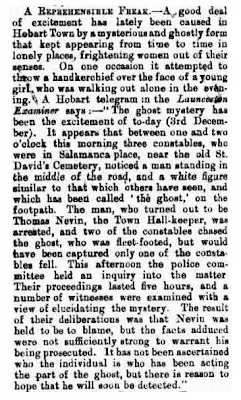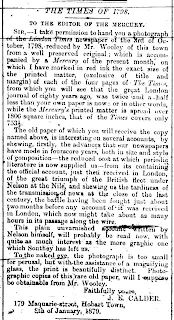
"A REPREHENSIBLE FREAK"
From The Maitland Mercury & Hunter River General Advertiser,
Thursday 16 December 1880, page 2
TRANSCRIPT
A REPREHENSIBLE FREAK.- A good deal of excitement has lately been caused in Hobart Town by a mysterious and ghostly form that kept appearing from time to time in lonely places, frightening women out of their senses. On one occasion it attempted to throw a handkerchief over the face of a young girl, who was walking out alone in the evening. A Hobart telegram in the Launceston Examiner says: -" The ghost mystery has been the excitement of to-day (3rd December). It appears that between one and two o'clock this morning three constables, who were in Salamanca place, near the old St. David's Cemetery, noticed a man standing in the middle of the road, and a white figure similar to that which others have seen, and which has been called ' the ghost,' on the footpath. The man, who turned out to be Thomas Nevin, the Town Hall-keeper, was arrested, and two of the constables chased the ghost, who was fleet-footed, but would have been captured only one of the constables fell. This afternoon the police committee held an inquiry into the matter. Their proceedings lasted five hours, and a number of witnesses were examined with a view of elucidating the mystery, The result of their deliberations was that Nevin was held to be to blame, but the facts adduced were not sufficiently strong to warrant his being prosecuted. It has not been ascertained who the individual is who has been acting the part of the ghost, but there is reason to hope that he will soon be detected."The NSW accounts appeared a fortnight later than the original report in the Tasmanian Mercury, December 4th, 1880:
EXCERPT from the Tasmanian Mercury:
... John Blakeney, constable in the City Police, deposed that he was on duty on the wharf as acting-sergeant, the previous night. While walking in the direction of Mr. Knight's stores, he saw two men at the corner. He walked over to them to ascertain who they were. As he was approaching them, both began to walk up Salamanca Place towards Davey-street. One split off into the middle of the road, and the other remained on the path on the left hand side, near the stores. Witness did not know who they were. The man in the centre of the road threw a reflection upon the one alongside the wall. The reflection was also upon the wall for a height of about 7 ft. Witness walked quickly towards the man in the road, and at the same time two men came stealthily out of George-street. Witness then commenced to run. One of those who came out of George-street said, "Come back, George." Witness replied, "Don't you see this fellow playing the ghost?" when the man in the middle of the road again threw a reflection upon the ghost. Witness arrested this man, who proved to be Nevin. The other two me pursued the man who had been acting as ghost. Nevin was taken to the police station, where he was searched at his own request. There was nothing that would account for the appearance of the ghost found upon him...Thomas Nevin was not charged, but he was dismissed from his position as keeper of the Hobart Town Hall for being intoxicated while on duty. The identity of the man in the white sheet who was responsible for Nevin's sudden change of fortune was not revealed, but Nevin must have known him. The name "George" was uttered at the critical moment the constable set after him in hot pursuit. The other named individual who appears often in the course of this report is Edwin Midwood, Information Clerk and colleague of Nevin's at the Town Hall Police Office, and father of caricaturist Thomas Claude Wade Midwood who published a cartoon lampooning the police ca. 1880.
... The man whom they pursued was dressed in white. The man ran up towards the Government Printing office, and witness gained upon him, nearly catching him at the corner of the building.The "ghost" made his escape to the Government Printing Office! Was he an employee, a fellow lithographer or photographer? At the start of this fateful night, Thomas Nevin -who "had a photographic apparatus and chemicals in his possession" - and photographer Henry Hall Baily were in Liverpool-street, looking at the "Night-changing Advertiser." The "Advertiser" was printed in Liverpool St at Mather's using photographer's real photo images for the lithographs used to illustrate advertisements which featured daily in the Mercury, and in the back pages of publications such as the Hobart Town Gazette, The Tasmanian Mail, The Hobart Town Courier, Walch's Tasmanian Almanac, and a number of smaller regional broadsheets (photographs were not reproduced in the press until 1887). But it was at the Government Printing Office where Thomas Nevin printed his carte-de-visite photographs of prisoners taken at the Hobart Gaol for the Police Department until the mid 1880s.
PRESS ILLUSTRATIONS
The first pictures in newspapers were woodcut illustrations and lithographs(fine pen and ink drawings). The first photographs to be used in Australian newspapers appeared in 1887 in the Adelaide newspaper The Pictorial Australian.
The first photographic images in the Sydney Morning Herald appeared on 21 August 1908 to illustrate the arrival in Sydney of a visiting United States Navy squadron. However, they were at first used very sparingly, mainly small portraits of people in the news. A small section of the paper was put aside especially for photographs before they gradually made their way to the main news pages.
Tasmanian photographers in Nevin's cohort were active in publishing for the press, in addition to their other income-generating activities. This early stereograph produced by Samuel Clifford, a partner of Nevin's in the 1860s and a grocer, was reproduced in the Melbourne Post.

The Museum of the Royal Society of Tasmania, photographed by Samuel Clifford in 1865 or earlier, was reproduced as a drawing by Albert Charles Cooke and engraved by R. Bruce. It was published in The Illustrated Melbourne Post on July 25, 1865, with "improvements" on reality (if reality is what photographs depict.) The windswept tree was removed and visitors and passers-by added.

THE ENGRAVING:
State Library of Victoria digital images:
Creator: Bruce, Robert, ca. 1839-1918 engraver.
Other creator(s): Cooke, A. C. (Albert Charles), 1836-1902 artist.
Hunter, Henry architect. Clifford, Samuel 1827-189- photographer. Royal Society of Tasmania.
Title: The Museum of the Royal Society of Tasmania. [picture]
Accession number(s): IMP25/07/65/108
Date(s) of creation: July 25, 1865.
Publication: Melbourne : Robert Stewart,
Medium: print : wood engraving.
Collection: Illustrated newspaper file. Illustrated Melbourne Post
Notes: Further information in Illustrated Newspaper File.
Drawn by Albert Charles Cooke and engraved by R. Bruce from a photograph by S. Clifford.
Wood engraving published in The Illustrated Melbourne Post.
Subject(s): Hobart (Tas.) Streets and roads 5 Argyle Street. Wood engravings.
THE STEREOGRAPH:
State Library of Victoria digital collections:
Creator: Clifford, Samuel 1827-189-, photographer.
Title: New Museum [Hobart] [picture]
Accession number(s): H29132
Date(s) of creation: [ca. 1859-ca. 1878]
Medium: 2 photographs : albumen silver stereograph ;
Dimensions: each 7.0 x 7.0 cm., on stereo card 9.0 x 18.0 cm. approx.
Collection: Victorian, interstate and overseas stereoscopic views. Views in Tasmania ;
Notes: Title inscribed on verso. Albumen silver photographs. Stereographs.
Charles A. Woolley (spelt "Wooley" in this article) - who maintained furniture warerooms from his photographic studio after 1870 - was lauded in this Mercury report of January 8th, 1879 for his photographic reproduction of the London Times 0f 1798:

Click on image for readable version
Charles Wooley [sic] also experimented with a substantial apparatus called the megalethoscope. The most prolific of the press illustrators were the Anson Brothers. Below is a typical spread from Walch's Tasmanian Almanac 1889, with two original photographs of Westella Family Hotel (the one on the right is by Alfred Winter), reproduced as a lithograph for the Almanac, but printed as a photograph for an Anson album.

Tasmanian Almanac 1889

University of Tasmania Special Collections
UTAS Note: Photograph from the collection of James Backhouse Walker of Pressland House, formerly J.P. Cowle's School, in 1881. (from notes by J. B. Walker on back of photograph). The building has a sign on the front which reads 'These premises for sale'. (see detail). During the 1840s Pressland House was the home of Mr Cowle's 'Hobart Town Classical and Commercial Academy'. (Craig, Clifford 'More old Tasmanian Prints', Launceston, Foot and Playsted, 1984 p.312). Photographer: A. Winter, Hobart Town - embossed on bottom left corner of photograph - (Alfred Winter had a photographic studio in Bathurst Street, Hobart from 1869-1891). Illustrated advertisement for Pressland House Private Boarding Establishment from Walch's Almanac 1889 indicates a substantial remodelling after 1881
RELATED POSTS main weblog
The Hobart Town Hall years 1876-1880
